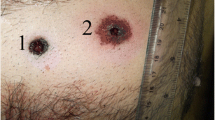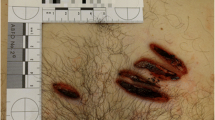Abstract
We present a case of a 56-year-old man who committed suicide using a captive-bolt gun, pressed against the left side of his chest. As the victim worked as a butcher, slaughtering livestock, he owned a captive-bolt gun. Just before committing suicide, he received a disturbing phone call from a person to whom he owed money. The autopsy revealed a 12-mm wound in the left pectoral region with two symmetrical, oval soot deposits. The wound extended through the fifth left rib, the pericardium, and the inferior portion of the anterior wall of the left ventricle. There was a partial-thickness tear in the left aspect of the interventricular septum with associated contusion. About 300 ml of the blood was found within the pericardial sack and about 1200 ml in the left pleural cavity. Atypical location (left chest vs. head), absence of previous suicide attempts and suicide note, and the apparent immediate provoking event suggest abrupt rather than premeditated suicide.
Similar content being viewed by others
Avoid common mistakes on your manuscript.
Case report
A 56-year-old man was found dead, sitting in a chair, in front of his house (Fig. 1a). A regular circular defect with slightly burned edges was apparent on his t-shirt on the left anterior chest (Fig. 1b). The t-shirt was pulled up during investigation, revealing a wound and two almost regular oval-shaped soot deposits on the surrounding skin. The upper-left deposit was better delineated (Fig. 1c). A captive-bolt gun was found on a table behind the body along with an empty cartridge RWS 9 × 17 (manufacture Rheinisch Westfälische Sprengstoff-Actien-Gesellschaft, caliber 9 × 17 mm) (Fig. 2a, b). Bloodstains were present on the captive-bolt gun (Fig. 2) and on the hands of the deceased, predominantly on the left hand (Fig. 1a). An autopsy was performed 3 days after the body was found.
The photographs were taken during police investigation. a The body of the deceased in front of the entrance door. b Closer aspect of the shirt defect. Note the burned parts of the fiber surrounding the shirt defect. c Closer aspect of the wound (asterisk) and two powder soot deposits after removing the shirt (arrows)
The deceased was 173 cm tall and weighed 80 kg. There was a regular round entrance wound with flat and smooth edges and about 12 mm in diameter (Fig. 3a, b) in the left pectoral region, between the parasternal and midclavicular line, with two almost regular oval powder soot deposits around the wound (Figs. 1c and 3a). External examination revealed no other injuries. The captive-bolt gun fractured the fifth left rib irregularly perforating it (Fig. 3c) and went through the pericardial sack, the inferior aspect of the anterior wall of the left ventricle (Fig. 4a) and, partially the left aspect of the interventricular septum with an associated contusion (Fig. 4b). There was about 300 ml of blood in the pericardial sack and about 1200 ml of blood in the left pleural cavity. Other autopsy findings included generalized anemia and subendocardial patchy hemorrhages, all attributed to hemorrhagic shock. Toxicological analyses performed on peripheral femoral blood, vitreous humor, and urine (GC–MS and LC–MS/MS) did not detect any psychoactive substances or alcohol.
During police investigation the wife of the deceased stated that he was a bus driver as well as a part-time butcher, and he owned the captive-bolt gun found at the scene. She found the captive-bolt gun next to the chair, on the right side of the deceased, and she subsequently placed the gun on the yard table prior to police arrival. She assumed that the possible suicide motive was debt to extortionate moneylenders. Just before committing suicide, the deceased received a disturbing phone call from a local loan-shark. Immediately after this phone call, he went out and committed suicide in front of the house. There were no previous suicide attempts, and he did not leave a suicide note. He was right-handed.
Discussion
Captive-bolt guns are used as weapons for slaughtering animals in the meat industry. The gun is typically placed against the animal’s forehead to induce immediate unconsciousness [1]. It consists of a simple cylindrical metal tube (barrel) about 30 cm long, with a heavy flange muzzle. A metal bolt placed in its center is launched upon discharge of a blank powder gun cartridge. The tips of the bolts are concave with very sharp edges, with an appearance of a sharp-edged circular punching tool [2]. If the front side of the gun is directly pressed against the surface at a proper angle, the sharp edge of the muzzle cuts the skin and leaves a wound with sharp edges [3] (Figs. 1c and 3b). After discharge, the bolt is pulled back into the barrel by a withdrawal spring. The muzzle has a central round opening from which the bolt is propelled beyond the muzzle. Beside the central hole, there are two additional side openings in the front side of the diverging smoke conduits, placed symmetrically around the central opening. These openings were the source of two round or oval-symmetrical powder soot deposits [2, 3] (Figs. 1b, c and 3a). Two major types of captive-bolt guns are available on the market: Kerner — the caliber and length of the bolt are 10.5 mm and 9 cm, respectively; and Schermer — the caliber and length of the bolt are 12 mm and 7.5 cm, respectively [3] (Fig. 2). However, there are a number of different copies with very similar technical properties [3] (Fig. 2). Given that only about one-third to one-half of the potential energy of the blank cartridge is transformed into kinetic energy of the captive bolt, the efficiency of captive-bolt devices is rather low [4]. Their maximum fire velocity is less than 50 m/s [5, 6].
There is a controversy whether the captive-bolt gun should be regulated as a weapon or as a tool [3]. In many Central and Southeast European countries the captive-bolt gun is considered a tool, and its purchase is not regulated [3, 7]. In English-speaking countries, captive-bolt guns are classified as weapons and regulated as such [7]. Suicides by captive-bolt guns are uncommon, likely due to their limited availability [7]. Czursiedel published the first report of a suicide with a slaughterer’s gun of the Kerner type [8]. Homicides are even less common, as captive-bolt guns are effective only when fired from a distance under 10 cm [9]. Accidental occupational injuries with a fatal outcome are also possible [10].
Most fatalities from captive-bolt guns are suicides (about 85%) [2, 3, 10, 11]. The vast majority of victims are males. The typical entrance site in such suicides is on the head [2, 3, 10, 11]. The most common wound location is the frontotemporal or frontal region, probably resulting from the ergonomical properties of the captive-bolt gun [3]. The captive-bolt gun is typically placed on the skin or at a close range [2]. A suicide with two different types of captive-bolt guns simultaneously fired to the head is very rare [12, 13], as is the use of this device in planned complex suicides [7, 14].
In the presented case, the appearance of the captive-bolt gun wound was typical: the concave bolt with very sharp edges made the regular round entrance wound about 12 mm in diameter with flat and smooth edges (Figs. 1c and 3a, b). The appearance of two symmetrical powder soot deposits surrounding the wound, formed by gases escaping through the side openings, is also typical (Figs. 1b, c and 3a). However, the location of the wound was atypical, including the injuries to the heart (Figs. 3b and 4). The fact that there was much more blood on the left hand suggests that the deceased used his left hand to hold the lower part of the captive-bolt, placing the muzzle on the skin in the projection of the heart, while using the dominant right hand to discharge the captive-bolt gun.
Factors that influence preferred methods of suicide include knowledge of the lethal effect of a substance or activity and the availability of a particular material or device [15]. Gender, occupation, location, and the psychological state of a person who attempts suicide have an influence on the mode of suicide, and the methods and tools for suicide are sometimes very bizarre and hard to recognize [12]. In this case, the deceased owned a captive-bolt gun; he knew its purpose and knew how to use it. The atypical location of the self-inflicted captive-bolt gun injury (left pectoral region), the absence of previous suicide attempts, and suicide note, and the apparent recent precipitating event suggest that this self-inflicted injury was impulsive rather than planned beforehand.
Data availability
Data available on request.
Code availability
Non-applicable.
References
DiMaio JV, DiMaio D. Forensic pathology. 2nd ed. London New York: CRC Press; 2001.
Simic M, Draskovic D, Stojiljkovic G, Vukovic R, Budimlija Z. The characteristics of head wound inflicted by humane killer (captive-bolt gun) – a 15-year study. J Forensic Sci. 2007;52:1182–5.
Gnjidic Z, Kubat M, Malenica T, Sajko T, Radic I, Rumboldt Z. Epidemiological, forensic, clinical and imaging characteristics of head injuries acquired in the suicide attempt with captive-bolt gun. Acta Neurochir. 2002;144:1271–7.
Dörfler K, Troeger K, Lücker E, Schönekeß H, Frank M. Determination of impact parameters and efficiency of 6.8/15 caliber captive-bolt guns. Int J Legal Med. 2014;128:641–46.
Yoganandan N, Pintar FA, Kumaresan S, Maiman DJ, Hargarten JW. Dynamic analysis of penetrating trauma. J Trauma. 1997;42:266–72.
Große Perdekamp M, Kneubuehl BP, Ishikawa T, Nadjem H, Kromeier J, Pollak S, Thierauf A. Secondary skull fractures in head wounds inflicted by captive-bolt guns: autopsy findings and experimental simulation. Int J Legal Med. 2010;124:605–12.
Viel G, Schröder AS, Püschel K, Braun C. Planned complex suicide by penetrating captive-bolt gunshot and hanging: case study and review of the literature. Forensic Sci Int. 2009;187:e7–11.
Pollak S, Rothschild MA. Gunshot injuries as a topic of medicolegal research in the German-speaking countries from the beginning of the 20th century up to the present time. Forensic Sci Int. 2004;144:201–10.
Betz P, Pankratz H, Penning R, Eisenmenger W. Homicide with captive-bolt pistol. Am J Forensic Med Pathol. 1993;14:54–7.
Ondruschka B, Heil K, Schulz S, Dreßler J, Morgenthal. Suizid oder Homizid? Eine rechtsmedizinische Auswertung letaler Bolzenschussverletzungen. Rechtsmedizin. 2018;28:413–19.
Hardt-Madsen M, Simonsen J. Firearms fatalities in Denmark 1970–1979. Forensic Sci Int. 1983;23:93–8.
Pircher R, Geisenberger D, Große Perdekamp M, Neukamm M, Pollak S, Schmidt U, Thierauf-Emberger A. Suicide with two makes of captive-bolt guns (livestock stunners) fired simultaneously to the forehead. Int J Legal Med. 2017;131:1557–64.
Fanton L, Karger B. Suicide with two shots to the head inflicted by a captive-bolt gun. J Forensic Legal Med. 2012;19:90–3.
Nikolić S, Živković V, Juković F. Planned complex occupation-related suicide by captive-bolt gunshot and hanging – case report. J Forensic Sci. 2011;56:248–51.
Austin A, Winskog C, van den Heuvel C, Byard RW. Recent trends in suicides utilizing helium. J Forensic Sci. 2011;56:649–51.
Funding
This work was supported by the Science Fund of the Republic of Serbia, IDEAS Program, Grant No. 7749444 (BoFraM project).
Author information
Authors and Affiliations
Corresponding author
Ethics declarations
Ethical approval
This article does not contain any studies with human participants or animals performed by any of the authors.
Consent to participate
This study was the result of a routine forensic autopsy and did not compromise any procedure; therefore, obtaining formal consent was not necessary.
Consent for publication
Non-applicable.
Conflict of interest
The authors declare no competing interests.
Additional information
Publisher's Note
Springer Nature remains neutral with regard to jurisdictional claims in published maps and institutional affiliations.
Rights and permissions
About this article
Cite this article
Nikolić, S., Atanasijević, T. & Živković, V. Unusual suicidal penetrating heart injury by captive-bolt gunshot. Forensic Sci Med Pathol 18, 260–263 (2022). https://doi.org/10.1007/s12024-021-00456-z
Accepted:
Published:
Issue Date:
DOI: https://doi.org/10.1007/s12024-021-00456-z








